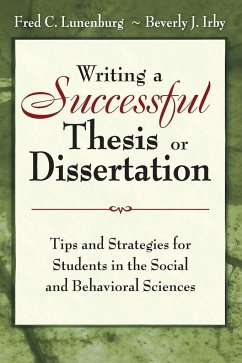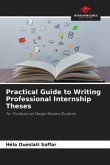Fred C Lunenburg, Beverly J Irby
Writing a Successful Thesis or Dissertation
Tips and Strategies for Students in the Social and Behavioral Sciences
Fred C Lunenburg, Beverly J Irby
Writing a Successful Thesis or Dissertation
Tips and Strategies for Students in the Social and Behavioral Sciences
- Gebundenes Buch
- Merkliste
- Auf die Merkliste
- Bewerten Bewerten
- Teilen
- Produkt teilen
- Produkterinnerung
- Produkterinnerung
The advice and resources you need to complete your thesis or dissertation! Written in a conversational style for both faculty and students, this how-to manual covers quantitative and qualitative research methods and provides comprehensive guidance for successfully completing a master's thesis or doctoral dissertation. Drawing on 40 years of experience supervising dissertations, the authors provide examples from 100 completed projects to guide readers through: * Choosing a topic and writing research hypotheses * Selecting a chair or committee * Ensuring a successful proposal and oral defense *…mehr
Andere Kunden interessierten sich auch für
![Practical Guide to Writing Professional Internship Theses Practical Guide to Writing Professional Internship Theses]() Héla Oueslati SaffarPractical Guide to Writing Professional Internship Theses30,99 €
Héla Oueslati SaffarPractical Guide to Writing Professional Internship Theses30,99 €![Successful Educators Successful Educators]() Nathan NaparstekSuccessful Educators101,99 €
Nathan NaparstekSuccessful Educators101,99 €![Effective Pedagogical Management and Successful International Teaching Effective Pedagogical Management and Successful International Teaching]() Michael RadinEffective Pedagogical Management and Successful International Teaching16,99 €
Michael RadinEffective Pedagogical Management and Successful International Teaching16,99 €![All Children Successful All Children Successful]() Vito GerminarioAll Children Successful64,99 €
Vito GerminarioAll Children Successful64,99 €![Sexualität und Partnerschaft bei Jugendlichen mit einer geistigen Behinderung Sexualität und Partnerschaft bei Jugendlichen mit einer geistigen Behinderung]() Susan Leue-KädingSexualität und Partnerschaft bei Jugendlichen mit einer geistigen Behinderung32,00 €
Susan Leue-KädingSexualität und Partnerschaft bei Jugendlichen mit einer geistigen Behinderung32,00 €![Successful Pathways for the Well-Being of Black Students Successful Pathways for the Well-Being of Black Students]() Successful Pathways for the Well-Being of Black Students173,99 €
Successful Pathways for the Well-Being of Black Students173,99 €![Eléments de dissertation et d¿initiation à la rédaction française Eléments de dissertation et d¿initiation à la rédaction française]() Joseph Kabeya MbomboEléments de dissertation et d¿initiation à la rédaction française27,99 €
Joseph Kabeya MbomboEléments de dissertation et d¿initiation à la rédaction française27,99 €-
-
-
The advice and resources you need to complete your thesis or dissertation! Written in a conversational style for both faculty and students, this how-to manual covers quantitative and qualitative research methods and provides comprehensive guidance for successfully completing a master's thesis or doctoral dissertation. Drawing on 40 years of experience supervising dissertations, the authors provide examples from 100 completed projects to guide readers through: * Choosing a topic and writing research hypotheses * Selecting a chair or committee * Ensuring a successful proposal and oral defense * Adapting the finished product for publication * Using the Internet and desktop publishing effectively
Hinweis: Dieser Artikel kann nur an eine deutsche Lieferadresse ausgeliefert werden.
Hinweis: Dieser Artikel kann nur an eine deutsche Lieferadresse ausgeliefert werden.
Produktdetails
- Produktdetails
- Verlag: Corwin
- Seitenzahl: 354
- Erscheinungstermin: 21. Dezember 2007
- Englisch
- Abmessung: 260mm x 183mm x 24mm
- Gewicht: 861g
- ISBN-13: 9781412942249
- ISBN-10: 1412942241
- Artikelnr.: 22970907
- Herstellerkennzeichnung
- Libri GmbH
- Europaallee 1
- 36244 Bad Hersfeld
- gpsr@libri.de
- Verlag: Corwin
- Seitenzahl: 354
- Erscheinungstermin: 21. Dezember 2007
- Englisch
- Abmessung: 260mm x 183mm x 24mm
- Gewicht: 861g
- ISBN-13: 9781412942249
- ISBN-10: 1412942241
- Artikelnr.: 22970907
- Herstellerkennzeichnung
- Libri GmbH
- Europaallee 1
- 36244 Bad Hersfeld
- gpsr@libri.de
Fred C. Lunenburg is Jimmy N. Merchant Professor of Education at Sam Houston State University. Previously, he was on the faculty of educational administration at the University of Louisville, Loyola University Chicago, and Southern Utah University, where he also served as Dean of the College of Education. In addition, he has held public school positions as a high school English teacher and reading specialist, high school assistant principal, high school principal, and superintendent of schools. Dr. Lunenburg's scholarship includes 45 books, 15 book chapters, and over 200 articles published in both practitioner and academic/research journals.
Preface
About the Authors
Part I. Getting Started
1. Selecting a Suitable Topic
Sources of Topics
Criteria for Topic Selection
Summary
2. Selecting a Chair and Committee
Criteria to Consider in Selecting a Chair
Composition and Role of the Committee
Research Prospective Committee Members
The Desirable Student
Summary
Part II. What You Need to Know
3. Quantitative Research Designs
Descriptive Research
Correlational Research
Causal-Comparative Research
Quasi-Experimental Research
Experimental Research
Theory Development
Summary
4. Basic Statistics
Descriptive Statistics
Inferential Statistics
Summary
5. Qualitative Research Designs
Phenomenological Research
Case Study Research
Ethnographic Research
Grounded Theory Research
Mixed Method Research
Summary
Part III. The Dissertation Chapters
6. Writing the Introduction Chapter
Background of the Study
Statement of the Problem
Purpose of the Study
Significance of the Study
Definition of Terms
Theoretical Framework
Models
Research Questions (or Hypotheses)
Limitations
Delimitations
Assumptions
Organization of the Study
Summary
7. Writing the Literature Review Chapter
Searching the Literature
Writing the Literature Review
Synthesizing the Literature
Summary
8. Writing the Methodology Chapter
Introduction
Selection of Participants
Instrumentation
Data Collection
Data Analysis
Summary
Conclusion
9. Writing the Results Chapter
Introduction
Descriptive Statistics
Testing the Research Questions (Hypotheses)
Additional Analyses
Summary
Conclusion
10. Writing the Discussion Chapter
Summary
Discussion
Implications for Practice
Recommendations for Further Research
Conclusions
Summary
Part IV. The Defense and Afterward
11. The Proposal and Final Defense
Prepare a Well-Written Document
Know the Format
Prepare Your Presentation
Practice Your Presentation
Anticipate Questions
Final Oral Defense
Tips on How to Avoid Common Mistakes
Summary
12. Publishing Your Dissertation
Presentations
Job Interview
Academic Journals
Books
Chapters in Books
Popular Press
Internet Publishing
Desktop Publishing
Planning the Writing Process
Summary
Appendix A: Initial Letter to Participants
Appendix B: First Follow-up Letter to Participants
Appendix C: Second Follow-up Letter to Participants
Appendix D: Dissertation Proposal Outline (Correlational)
Appendix E: Dissertation Proposal Outline (Analysis of Variance)
Appendix F: Dissertation Proposal Outline (Multivariate Analysis of
Variance)
Appendix G: Dissertation Proposal Outline (Qualitative)
Appendix H: The Qualitative Research Critique
Appendix I: Agreement: Guidelines for Chairing a Dissertation
Appendix J: Checklist for Dissertation Quality
References
Index
About the Authors
Part I. Getting Started
1. Selecting a Suitable Topic
Sources of Topics
Criteria for Topic Selection
Summary
2. Selecting a Chair and Committee
Criteria to Consider in Selecting a Chair
Composition and Role of the Committee
Research Prospective Committee Members
The Desirable Student
Summary
Part II. What You Need to Know
3. Quantitative Research Designs
Descriptive Research
Correlational Research
Causal-Comparative Research
Quasi-Experimental Research
Experimental Research
Theory Development
Summary
4. Basic Statistics
Descriptive Statistics
Inferential Statistics
Summary
5. Qualitative Research Designs
Phenomenological Research
Case Study Research
Ethnographic Research
Grounded Theory Research
Mixed Method Research
Summary
Part III. The Dissertation Chapters
6. Writing the Introduction Chapter
Background of the Study
Statement of the Problem
Purpose of the Study
Significance of the Study
Definition of Terms
Theoretical Framework
Models
Research Questions (or Hypotheses)
Limitations
Delimitations
Assumptions
Organization of the Study
Summary
7. Writing the Literature Review Chapter
Searching the Literature
Writing the Literature Review
Synthesizing the Literature
Summary
8. Writing the Methodology Chapter
Introduction
Selection of Participants
Instrumentation
Data Collection
Data Analysis
Summary
Conclusion
9. Writing the Results Chapter
Introduction
Descriptive Statistics
Testing the Research Questions (Hypotheses)
Additional Analyses
Summary
Conclusion
10. Writing the Discussion Chapter
Summary
Discussion
Implications for Practice
Recommendations for Further Research
Conclusions
Summary
Part IV. The Defense and Afterward
11. The Proposal and Final Defense
Prepare a Well-Written Document
Know the Format
Prepare Your Presentation
Practice Your Presentation
Anticipate Questions
Final Oral Defense
Tips on How to Avoid Common Mistakes
Summary
12. Publishing Your Dissertation
Presentations
Job Interview
Academic Journals
Books
Chapters in Books
Popular Press
Internet Publishing
Desktop Publishing
Planning the Writing Process
Summary
Appendix A: Initial Letter to Participants
Appendix B: First Follow-up Letter to Participants
Appendix C: Second Follow-up Letter to Participants
Appendix D: Dissertation Proposal Outline (Correlational)
Appendix E: Dissertation Proposal Outline (Analysis of Variance)
Appendix F: Dissertation Proposal Outline (Multivariate Analysis of
Variance)
Appendix G: Dissertation Proposal Outline (Qualitative)
Appendix H: The Qualitative Research Critique
Appendix I: Agreement: Guidelines for Chairing a Dissertation
Appendix J: Checklist for Dissertation Quality
References
Index
Preface
About the Authors
Part I. Getting Started
1. Selecting a Suitable Topic
Sources of Topics
Criteria for Topic Selection
Summary
2. Selecting a Chair and Committee
Criteria to Consider in Selecting a Chair
Composition and Role of the Committee
Research Prospective Committee Members
The Desirable Student
Summary
Part II. What You Need to Know
3. Quantitative Research Designs
Descriptive Research
Correlational Research
Causal-Comparative Research
Quasi-Experimental Research
Experimental Research
Theory Development
Summary
4. Basic Statistics
Descriptive Statistics
Inferential Statistics
Summary
5. Qualitative Research Designs
Phenomenological Research
Case Study Research
Ethnographic Research
Grounded Theory Research
Mixed Method Research
Summary
Part III. The Dissertation Chapters
6. Writing the Introduction Chapter
Background of the Study
Statement of the Problem
Purpose of the Study
Significance of the Study
Definition of Terms
Theoretical Framework
Models
Research Questions (or Hypotheses)
Limitations
Delimitations
Assumptions
Organization of the Study
Summary
7. Writing the Literature Review Chapter
Searching the Literature
Writing the Literature Review
Synthesizing the Literature
Summary
8. Writing the Methodology Chapter
Introduction
Selection of Participants
Instrumentation
Data Collection
Data Analysis
Summary
Conclusion
9. Writing the Results Chapter
Introduction
Descriptive Statistics
Testing the Research Questions (Hypotheses)
Additional Analyses
Summary
Conclusion
10. Writing the Discussion Chapter
Summary
Discussion
Implications for Practice
Recommendations for Further Research
Conclusions
Summary
Part IV. The Defense and Afterward
11. The Proposal and Final Defense
Prepare a Well-Written Document
Know the Format
Prepare Your Presentation
Practice Your Presentation
Anticipate Questions
Final Oral Defense
Tips on How to Avoid Common Mistakes
Summary
12. Publishing Your Dissertation
Presentations
Job Interview
Academic Journals
Books
Chapters in Books
Popular Press
Internet Publishing
Desktop Publishing
Planning the Writing Process
Summary
Appendix A: Initial Letter to Participants
Appendix B: First Follow-up Letter to Participants
Appendix C: Second Follow-up Letter to Participants
Appendix D: Dissertation Proposal Outline (Correlational)
Appendix E: Dissertation Proposal Outline (Analysis of Variance)
Appendix F: Dissertation Proposal Outline (Multivariate Analysis of
Variance)
Appendix G: Dissertation Proposal Outline (Qualitative)
Appendix H: The Qualitative Research Critique
Appendix I: Agreement: Guidelines for Chairing a Dissertation
Appendix J: Checklist for Dissertation Quality
References
Index
About the Authors
Part I. Getting Started
1. Selecting a Suitable Topic
Sources of Topics
Criteria for Topic Selection
Summary
2. Selecting a Chair and Committee
Criteria to Consider in Selecting a Chair
Composition and Role of the Committee
Research Prospective Committee Members
The Desirable Student
Summary
Part II. What You Need to Know
3. Quantitative Research Designs
Descriptive Research
Correlational Research
Causal-Comparative Research
Quasi-Experimental Research
Experimental Research
Theory Development
Summary
4. Basic Statistics
Descriptive Statistics
Inferential Statistics
Summary
5. Qualitative Research Designs
Phenomenological Research
Case Study Research
Ethnographic Research
Grounded Theory Research
Mixed Method Research
Summary
Part III. The Dissertation Chapters
6. Writing the Introduction Chapter
Background of the Study
Statement of the Problem
Purpose of the Study
Significance of the Study
Definition of Terms
Theoretical Framework
Models
Research Questions (or Hypotheses)
Limitations
Delimitations
Assumptions
Organization of the Study
Summary
7. Writing the Literature Review Chapter
Searching the Literature
Writing the Literature Review
Synthesizing the Literature
Summary
8. Writing the Methodology Chapter
Introduction
Selection of Participants
Instrumentation
Data Collection
Data Analysis
Summary
Conclusion
9. Writing the Results Chapter
Introduction
Descriptive Statistics
Testing the Research Questions (Hypotheses)
Additional Analyses
Summary
Conclusion
10. Writing the Discussion Chapter
Summary
Discussion
Implications for Practice
Recommendations for Further Research
Conclusions
Summary
Part IV. The Defense and Afterward
11. The Proposal and Final Defense
Prepare a Well-Written Document
Know the Format
Prepare Your Presentation
Practice Your Presentation
Anticipate Questions
Final Oral Defense
Tips on How to Avoid Common Mistakes
Summary
12. Publishing Your Dissertation
Presentations
Job Interview
Academic Journals
Books
Chapters in Books
Popular Press
Internet Publishing
Desktop Publishing
Planning the Writing Process
Summary
Appendix A: Initial Letter to Participants
Appendix B: First Follow-up Letter to Participants
Appendix C: Second Follow-up Letter to Participants
Appendix D: Dissertation Proposal Outline (Correlational)
Appendix E: Dissertation Proposal Outline (Analysis of Variance)
Appendix F: Dissertation Proposal Outline (Multivariate Analysis of
Variance)
Appendix G: Dissertation Proposal Outline (Qualitative)
Appendix H: The Qualitative Research Critique
Appendix I: Agreement: Guidelines for Chairing a Dissertation
Appendix J: Checklist for Dissertation Quality
References
Index








